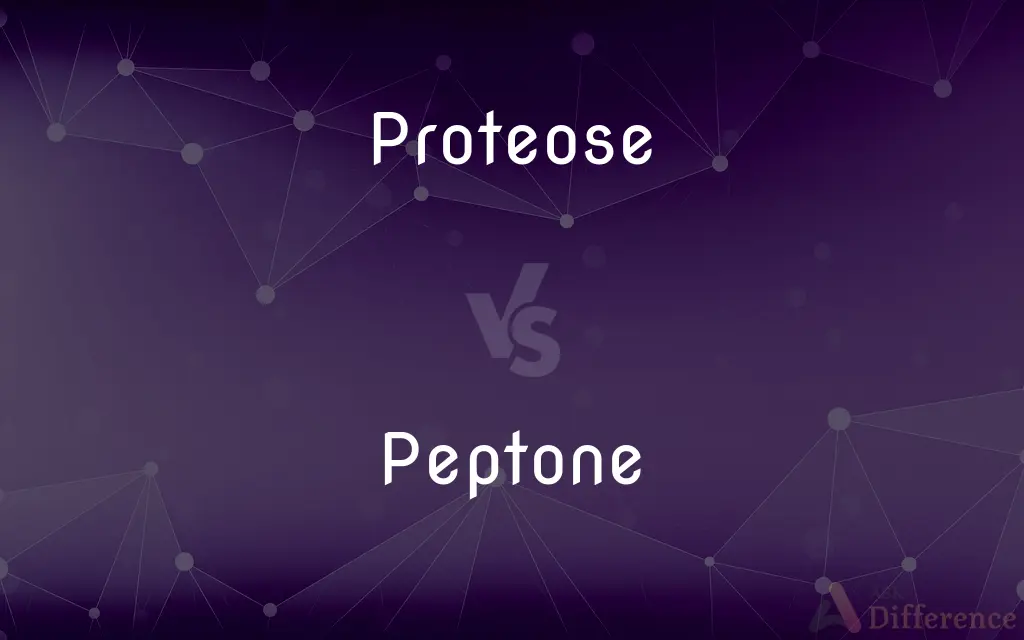Proteose vs. Peptone — What's the Difference?
By Urooj Arif & Maham Liaqat — Updated on April 9, 2024
Proteose is a form of partially hydrolyzed protein, smaller than peptones, which are also partially digested proteins but are larger and closer to the original protein in structure.

Difference Between Proteose and Peptone
Table of Contents
ADVERTISEMENT
Key Differences
Proteose and peptone are both products of protein hydrolysis, a process where proteins are broken down into smaller components. Proteose is created through further hydrolysis of peptones, resulting in smaller molecules that are more soluble and have a lower molecular weight. In contrast, peptones are intermediate products of protein digestion, larger than proteoses and amino acids but smaller than the original proteins. They retain more of the protein's properties and are used in various applications for their nutritive value.
Proteose, due to its smaller size, is easily assimilated and used in biochemical research and industries for its functional properties, such as solubility and diffusibility. Peptones, on the other hand, are primarily used in microbiological media and in the food industry as nutritional supplements due to their ability to provide a rich source of nitrogen and other nutrients essential for microbial growth.
The production process for both involves the enzymatic or chemical breakdown of proteins from animal or plant sources. However, the extent of hydrolysis and the specific enzymes or chemicals used can influence whether the end product is more proteose or peptone-like in nature.
Both proteose and peptone find roles in scientific research, particularly in microbiology, where they serve as essential components in culture media, facilitating the growth of a wide range of microorganisms. The choice between using proteose or peptone depends on the specific requirements of the microorganisms being cultured and the desired outcomes of the research or industrial process.
Despite their differences, proteose and peptone are crucial for understanding protein chemistry and for applications in biotechnology and the food industry, showcasing the versatility of protein hydrolysis products.
ADVERTISEMENT
Comparison Chart
Size
Smaller, more hydrolyzed molecules
Larger, less hydrolyzed than proteose
Solubility
Higher solubility and diffusibility
Lower solubility than proteose, but higher than proteins
Molecular Weight
Lower molecular weight
Higher molecular weight than proteose
Production
Further hydrolysis of peptones
Partial hydrolysis of proteins
Uses
Biochemical research, industries for its functional properties
Microbiological media, food industry as nutritional supplements
Compare with Definitions
Proteose
A highly hydrolyzed form of protein.
Proteose is used in certain diagnostic media to distinguish bacterial species.
Peptone
A partially digested protein used in culture media.
Peptone provides essential nutrients in agar plates for bacterial culture.
Proteose
Results from the further breakdown of peptones.
By hydrolyzing peptones, researchers can obtain proteose for detailed protein studies.
Peptone
Essential for microbial growth in research.
Scientists use peptone to cultivate a wide range of bacteria and fungi in the lab.
Proteose
Functions due to its unique properties.
The diffusibility of proteose is exploited in creating gradients for microbiological assays.
Peptone
Larger and less hydrolyzed than proteose.
Peptone's size makes it a versatile nutrient source in microbiological media.
Proteose
Characterized by small size and high solubility.
Proteose's solubility makes it ideal for studying protein behavior in solution.
Peptone
Obtained from animal or plant protein sources.
Soy peptone is a common, plant-based alternative to animal-derived peptones.
Proteose
Used in biochemical research.
Proteose supplements in media promote the growth of fastidious microorganisms.
Peptone
Nutritional supplement in the food industry.
Peptone is added to some food products to enhance their protein content.
Proteose
A proteose is any of various water-soluble compounds that are produced during in-vitro or in-vivo hydrolytic breakdown of proteins a little before producing amino acids. It forms after breaking down of polypeptides by proteases such as gastric pepsin.
Peptone
Any of various water-soluble protein derivatives formed by partial hydrolysis or digestion of proteins by an acid or enzyme, used in culture media in bacteriology.
Proteose
Any of various water-soluble compounds that are produced during digestion by the hydrolytic breakdown of proteins.
Peptone
(biochemistry) Any water-soluble mixture of polypeptides and amino acids formed by the partial hydrolysis of protein.
Proteose
A mixture of peptides produced by the hydrolysis of proteins.
Peptone
The soluble polypeptides produced by hydrolysis of protein; specifically the soluble peptides into which food is transformed by the action of the gastric and pancreatic juices. Peptones are also formed from protein matter by the action of boiling water and boiling dilute acids.
Proteose
One of a class of soluble products formed in the digestion of proteids with gastric and pancreatic juice, and also by the hydrolytic action of boiling dilute acids on proteids. Proteoses are divided into the two groups, the primary and secondary proteoses.
Peptone
Any of various water-soluble compounds that form by hydrolysis in the digestion of proteins to amino acids
Common Curiosities
Why are proteose and peptone important in microbiology?
They provide essential nutrients and facilitate the growth of microorganisms in culture media.
What applications do proteose and peptone have outside of microbiology?
They are used in the food industry as nutritional supplements and in biochemical research for studying protein interactions.
Can peptone be converted into proteose?
Yes, peptone can be further hydrolyzed to produce proteose.
How do the properties of proteose and peptone affect their use in research?
Their solubility, molecular weight, and nutritive value determine their suitability for different types of scientific and industrial applications.
What is the main difference between proteose and peptone?
Proteose is smaller and results from further hydrolysis of peptones, making it more soluble.
Is peptone suitable for all types of microbial culture?
While peptone is versatile, the specific requirements of the microorganism being cultured may necessitate adjustments or supplements to the media.
How are proteose and peptone produced?
Both are produced by hydrolyzing proteins, with proteose undergoing a more extensive breakdown process.
What role does solubility play in the use of proteose and peptone?
Solubility influences how these substances are used in solutions and affects their biological availability in culture media.
Are proteose and peptone derived from specific protein sources?
They can be derived from a variety of animal and plant protein sources, depending on the intended use.
Can the use of proteose and peptone in food products affect human health?
When used appropriately, they can enhance the nutritional value of foods without adverse health effects, although individual sensitivities or allergies to the source material can occur.
Share Your Discovery

Previous Comparison
Gehenna vs. Hades
Next Comparison
Axle vs. FulcrumAuthor Spotlight
Written by
Urooj ArifUrooj is a skilled content writer at Ask Difference, known for her exceptional ability to simplify complex topics into engaging and informative content. With a passion for research and a flair for clear, concise writing, she consistently delivers articles that resonate with our diverse audience.
Co-written by
Maham Liaqat











































